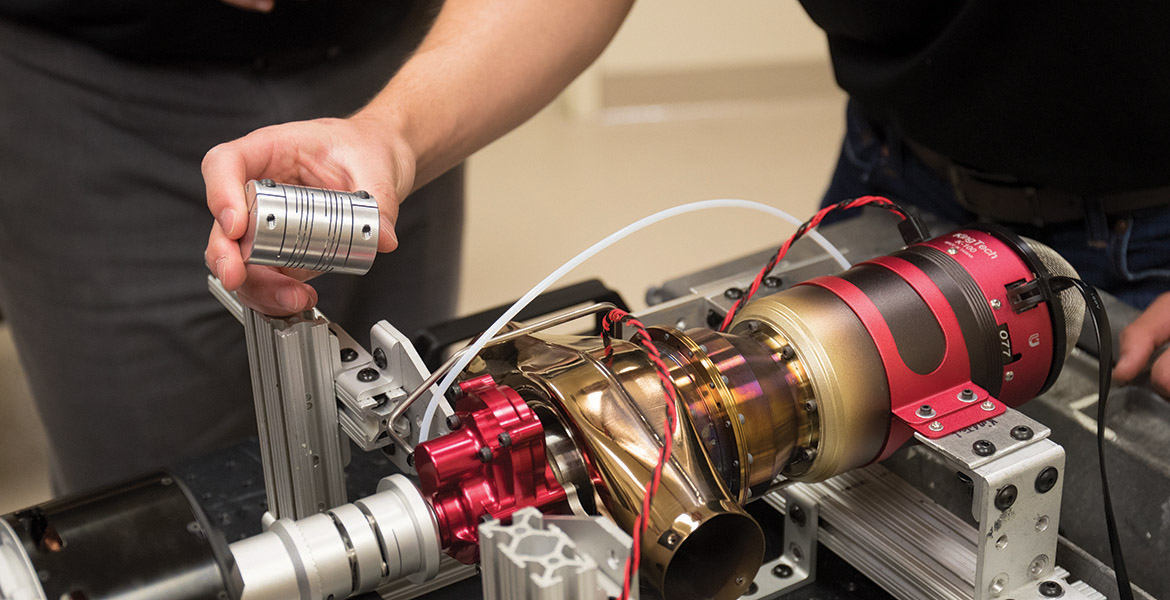
Powering the future of flight
Friday, December 18, 2020
"Sometimes life takes unexpected turns in the right direction."
Dr. Kurt Rouser didn’t know how true that quote would be for himself and numerous students after a conversation he had in the fall of 2017.
The assistant professor in mechanical and aerospace engineering at Oklahoma State University has led various groups of students in researching the development and construction of a hybrid electric propulsion system for aircraft. The endeavor started after a conversation with a local oil and gas company that was interested in exploring new methods for pipeline inspections. The company was using electric multirotor drones to inspect pipelines, but restrictions on using those meant the company was taking upwards of three weeks to inspect 100 miles of pipeline.
Following the conversation, Rouser set out to create a turboelectric propulsion system that could harness the energy density of hydrocarbon fuel to dramatically increase the operational efficiency of the drone. In the spring of 2018, the Oklahoma Center for the Advancement of Science and Technology (OCAST) granted two years of funding for the project.
The first year was spent characterizing power systems and working on subsystem development. Rouser and his students measured the response time of turbine engines and the efficiency of different electrical system setups to determine the greatest output and efficiency, while taking into consideration certain parameters and the limitations of the system being integrated into an unmanned aircraft system.
Once the design and build specifications of the system were determined, Rouser assigned a new group of students to identify the challenges of integrating the system into an aircraft in the fall of 2019. The senior design project team meticulously analyzed potential problems in the structural design of the aircraft, the thermal management of the hybrid electric propulsion system, the system’s reaction to vibration experienced during use and the aircraft inlet size for the amount of cooling flow that would be required to keep the system within operating parameters, as a capstone project.
"This project has the potential to impact this growing technology internationally, which is a testament to the caliber of students we have in CEAT."
Rouser also submitted the project to FirePoint Innovations Center at Wichita State University’s Converge, Collaborate and Create competition. FirePoint works in collaboration with the U.S. Army Combat Capabilities Development Command Aviation and Missile Center to expose tomorrow’s bright minds to the newest manufacturing technologies in order to develop the next workforce. The competition chooses 10 teams to fund a proof of concept of their submissions. From there, the selected teams present their proofs of concepts, and three teams are chosen to move into the final phase of the competition and work together to implement their projects into real-world applications. Rouser’s team was selected to move into the final phase and is working on developing a working prototype.
This also coincides with the recent awarding of $600,000 in funding over a three-year period from the Federal Aviation Administration. The first year of the FAA project will be used to finish developing a subscale (unmanned) version of their hybrid electric propulsion system. The second and third year will be used to design and develop a full-scale testing unit that will provide a testing apparatus for future iterations of this technology.
“This testing unit will help the FAA develop certification and validation standards for the safe integration of these hybrid electric propulsion units,” Rouser said. “The FAA is turning to [OSU] for the practical and safe integration of these systems.” He says this partnership and its results will reinforce OSU and CEAT as cornerstones in the emerging market, which many believe will be a necessity for the urban air mobility movement.
“I’m extremely proud of the work our students have done over the last three years,” Rouser said. “This project has the potential to impact this growing technology internationally, which is a testament to the caliber of students we have in the College of Engineering, Architecture and Technology.”
